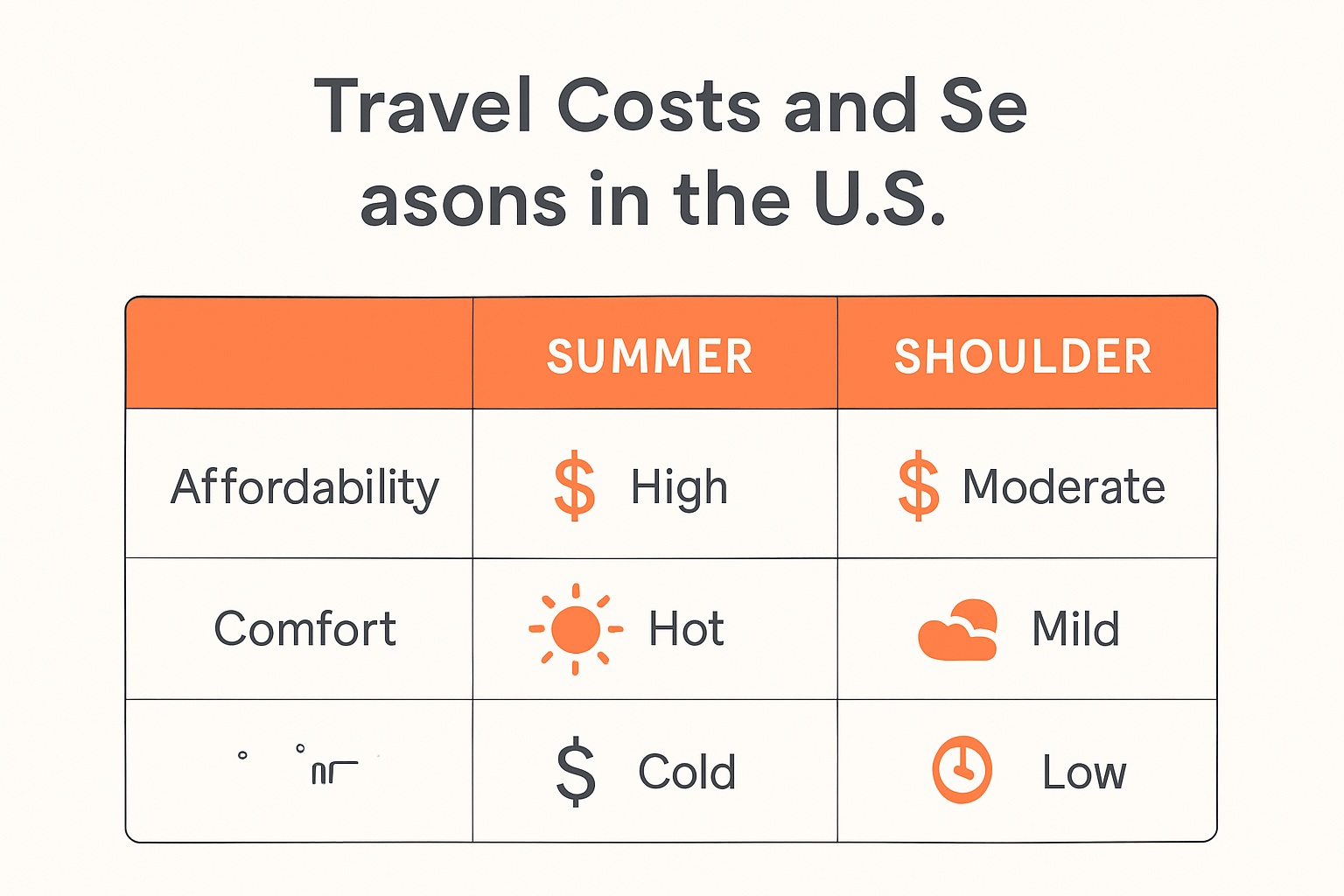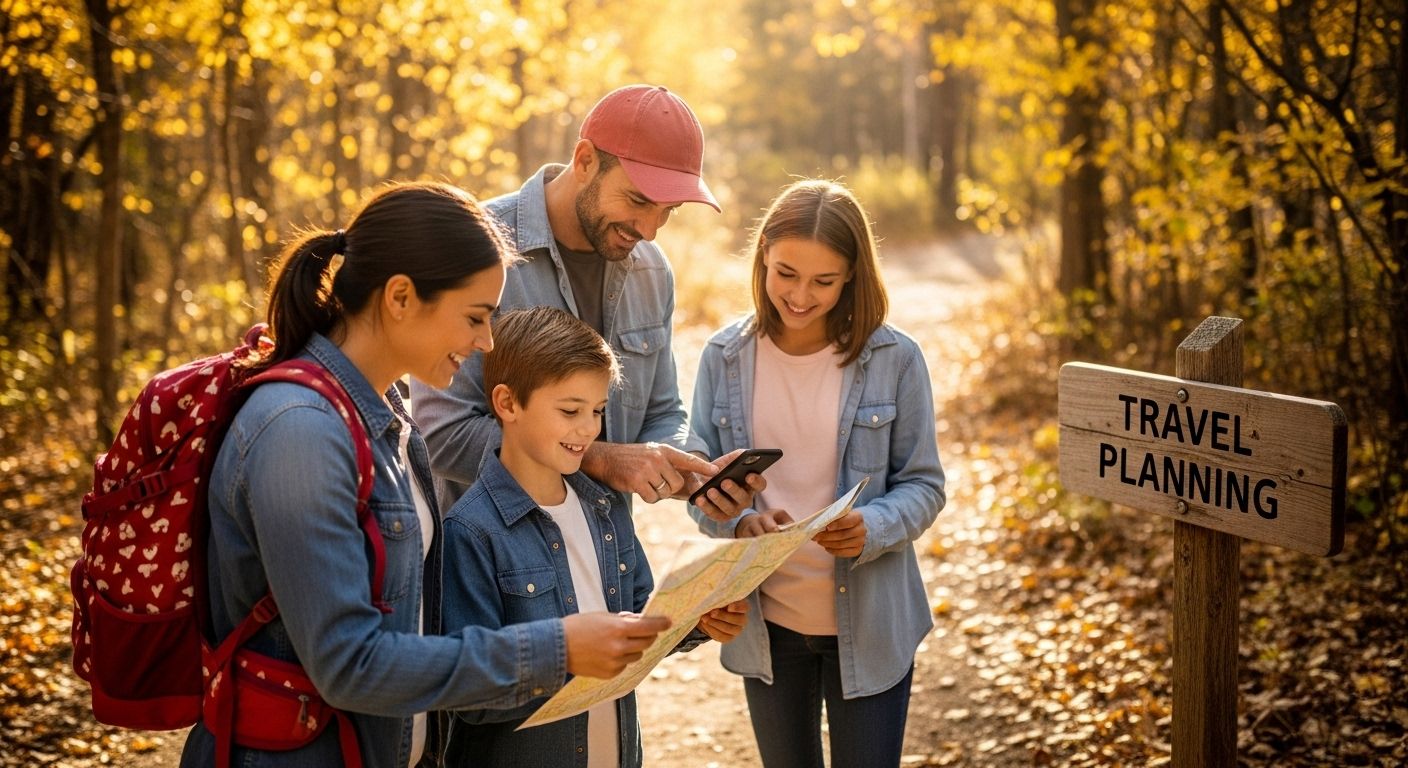Planning the perfect trip across the United States can feel impossible when every region changes so dramatically with the seasons. One moment you are eyeing the crowds at Yellowstone, the next you are dreaming of quiet fall foliage in New England. But get this. 74% of Americans are sticking to summer travel plans in 2025 even as costs and crowds hit record highs. Turns out, the real sweet spot for savvy travelers? Saving hundreds by timing your journey with the secret power of shoulder seasons.
Table of Contents
- How Seasons Affect The Best Time To Travel
- Top Destinations In Each Season
- Tips For Families And Solo Travelers
- Travel Planning Advice For 2025
Quick Summary
| Takeaway | Explanation |
|---|---|
| Plan trips around seasonal dynamics | Understanding how seasons affect travel can maximize enjoyment and minimize challenges during your journey. |
| Choose destinations based on timing | Each season offers unique attractions, so select destinations that shine during your planned travel period. |
| Leverage shoulder seasons for savings | Traveling during off-peak times can significantly reduce costs for accommodations and transportation. |
| Utilize technology for travel efficiency | Mobile apps can streamline trip planning, offering real-time updates and helpful recommendations. |
| Prioritize flexible travel arrangements | Ensure booking options allow changes or cancellations to adapt to unforeseen circumstances during your trip. |
How Seasons Affect the Best Time to Travel
Traveling across the United States involves strategic seasonal planning that can dramatically impact your experience, budget, and overall enjoyment. Understanding how seasonal variations influence travel can help you make informed decisions and optimize your journey.
Seasonal Travel Dynamics and Weather Patterns
Weather plays a crucial role in determining the best time to travel. Each season offers unique characteristics that can either enhance or challenge your travel plans. According to National Oceanic and Atmospheric Administration, seasonal weather patterns can significantly impact travel conditions and opportunities.
Summer presents warm temperatures ideal for outdoor adventures, national park visits, and coastal trips. Peak tourist seasons during summer mean higher prices and crowded destinations. Conversely, shoulder seasons like late spring and early fall offer more comfortable temperatures and reduced crowds. Smithsonian Magazine recommends visiting national parks during these transitional periods for optimal experiences.
Regional Seasonal Variations
The United States encompasses diverse geographical regions with dramatically different seasonal experiences. The Southwest offers mild winters and scorching summers, while the Northeast experiences dramatic seasonal shifts with cold winters and mild summers. Mountain regions like Colorado and Wyoming provide year round outdoor activities, transforming from skiing destinations in winter to hiking paradises in summer.
Winter travel requires careful planning, especially in northern states where snowstorms can disrupt transportation. Ski resorts in Colorado, Utah, and Vermont become prime destinations during cold months. Summer brings opportunities for road trips, coastal vacations, and national park explorations.
Cost and Accessibility Considerations
Seasonal travel significantly impacts pricing and availability. Peak seasons like summer and winter holidays typically feature higher prices for accommodations and transportation. Budget conscious travelers can leverage shoulder seasons for more affordable travel experiences. Flexibility with travel dates can result in substantial savings.
Airline and hotel prices fluctuate dramatically based on seasonal demand. Traveling during off peak periods can provide substantial discounts and more personalized experiences. Understanding these seasonal variations allows travelers to strategically plan trips that balance cost, comfort, and desired experiences.
Successful travel planning requires understanding how seasons interact with your destination, budget, and personal preferences. By carefully analyzing seasonal dynamics, you can craft memorable journeys that maximize enjoyment while minimizing potential challenges.

Top Destinations in Each Season
Exploring the United States through its diverse seasonal landscapes reveals incredible destinations that transform dramatically throughout the year. Understanding the unique charm of each location during different seasons can help travelers plan unforgettable experiences across the country.
Winter Wonderland Destinations
Winter transforms certain regions into magical landscapes perfect for travelers seeking snow and adventure. National Geographic highlights several must visit winter destinations. Alaska offers extraordinary northern lights viewing and winter wildlife experiences. In the lower 48 states, destinations like Aspen, Colorado provide world class skiing and snowboarding opportunities. Park City, Utah and Stowe, Vermont also rank among top winter sports destinations.
National parks take on breathtaking characteristics during winter. Yellowstone National Park becomes a serene snow covered landscape where wildlife like bison and elk roam against pristine white backgrounds. Grand Teton National Park offers incredible winter photography opportunities and cross country skiing trails.
Spring Bloom and Cultural Destinations
Spring brings renewal and vibrant experiences across the United States. Washington DC becomes particularly stunning during cherry blossom season, with Smithsonian Gardens showcasing spectacular floral displays. California’s Napa Valley offers mild temperatures perfect for wine tours and exploring emerging vineyard landscapes.
Southwestern states like Arizona and New Mexico provide ideal spring conditions for desert wildflower viewing and outdoor exploration. National parks such as Saguaro National Park burst with colorful desert blooms, creating spectacular visual experiences for nature enthusiasts.
Summer and Fall Adventure Destinations
Summer opens opportunities for coastal and mountain adventures. Hawaii offers perfect beach experiences with multiple islands providing unique landscapes. Alaska becomes remarkably accessible during summer months, offering midnight sun experiences and incredible wildlife viewing in national parks like Denali.
Fall transforms destinations like New England into breathtaking color palettes. Vermont, New Hampshire, and Maine provide spectacular autumn foliage experiences. The Great Smoky Mountains National Park becomes particularly stunning during fall, with mountain landscapes covered in rich red, orange, and yellow hues.
Mountain regions like Colorado offer year round experiences. Rocky Mountain National Park provides summer hiking and wildlife viewing, transitioning to winter skiing and snowshoeing opportunities. This versatility makes mountain destinations particularly attractive for travelers seeking diverse seasonal experiences.
Choosing destinations requires understanding their seasonal characteristics. Some locations shine brightest during specific times of year, offering unique experiences that cannot be replicated elsewhere. Flexible travelers who research destination specific seasonal attributes can craft extraordinary journeys across the United States.
Here is a table summarizing top destinations by season to help you match your travel goals with the ideal time of year:
| Season | Top Destinations | Highlights / Experiences |
|---|---|---|
| Winter | Alaska, Aspen (CO), Park City (UT), Stowe (VT), Yellowstone, Grand Teton | Northern lights, skiing, snowboarding, winter wildlife, scenic photography, cross-country skiing |
| Spring | Washington DC, Napa Valley (CA), Arizona, New Mexico, Saguaro NP | Cherry blossoms, wine tours, desert blooms, outdoor hiking, cultural events |
| Summer | Hawaii, Alaska, Denali NP, Coastal California | Beaches, midnight sun, wildlife viewing, national park adventures |
| Fall | New England (VT, NH, ME), Great Smoky Mountains NP, Colorado | Fall foliage, hiking, mountain scenery, autumn festivals |
Tips for Families and Solo Travelers
Traveling across the United States offers unique experiences for both families and solo adventurers. Understanding the nuanced approaches to travel planning can transform your journey from ordinary to extraordinary.
Family Travel Strategies
Planning a family vacation requires careful consideration of multiple factors. Marist Poll indicates that 57% of Americans plan to vacation in summer 2025, with a significant portion focusing on domestic travel. Successful family trips demand strategic planning that balances everyone’s interests and comfort levels.
Consider destinations that offer diverse activities catering to different age groups. National parks provide excellent opportunities for family bonding through shared outdoor experiences. Look for locations with interactive museums, junior ranger programs, and kid friendly hiking trails. Some destinations offer family packages that include multiple activities, reducing individual ticket costs and planning complexity.
Budget management becomes crucial for family travelers. According to the SSRS Opinion Panel, 74% of Americans plan summer travel, with 54% considering in state trips. This trend suggests families are becoming more cost conscious. Strategies like booking accommodations with kitchen facilities, packing snacks, and selecting destinations with free or low cost attractions can significantly reduce overall travel expenses.
Below is a table outlining key strategies for family and solo travel based on the article’s recommendations:
| Traveler Type | Planning Strategies | Cost-Saving Tips | Suggested Destinations |
|---|---|---|---|
| Family | Balance interests/ages; prioritize bonding activities; look for family packages | Book lodging with kitchens; pack snacks; choose free/low-cost attractions | National Parks, Museums |
| Solo | Prioritize flexibility & safety; use travel apps; choose solo-friendly places | Use public transport; off-peak travel; tech tools | Urban centers, Parks with transit |
Solo Travel Insights
Solo travelers enjoy unique advantages including complete itinerary flexibility and personal growth opportunities. The key to successful solo travel lies in thorough preparation and maintaining personal safety. Choose destinations with robust public transportation, welcoming local cultures, and multiple accommodation options.
Technology can be a solo traveler’s best companion. Use travel apps that provide real time navigation, translation services, and local recommendations. Consider destinations with strong digital infrastructure and traveler friendly environments. National parks, urban centers with good public transit, and regions with established tourism industries make excellent solo travel destinations.
Universal Travel Planning Tips
Regardless of travel style, certain strategies benefit all travelers. The US Family Travel Survey highlights increasing interest in diverse travel periods, with 33% planning Thanksgiving trips and 42% considering winter holiday vacations. This trend suggests travelers are becoming more flexible and creative with their travel planning.
Prioritize travel insurance, especially for trips involving multiple destinations or outdoor activities. Research destination specific health requirements, pack versatile clothing, and maintain a flexible itinerary. Solo travelers should share their travel plans with trusted contacts, while families might consider walkie talkies or location sharing apps during group activities.
Understanding your personal travel style, budget constraints, and comfort levels will help craft the most enjoyable travel experience. Whether traveling with family or exploring solo, the United States offers incredible diversity to suit every traveler’s preferences. Approach your journey with preparation, an open mind, and a sense of adventure.
Travel Planning Advice for 2025
Travel in 2025 demands strategic planning and adaptability. With shifting travel trends and emerging opportunities, travelers need comprehensive approaches to maximize their experiences and minimize potential challenges.
Economic and Booking Considerations
The U.S. Travel Association projects a 3.9% growth in total U.S. travel spending, reaching $1.35 trillion in 2025. This economic landscape suggests increased competition for travel resources and potential price fluctuations. Savvy travelers should book early and remain flexible with their plans.
Domestic travel continues to dominate travel preferences. Marist Poll reveals that 71% of Americans prefer domestic destinations, with 45% seeking rest and relaxation. This trend indicates a growing market for destinations offering tranquil experiences and convenient accessibility.
Budget conscious travelers should leverage advance booking strategies. Compare prices across multiple platforms, consider package deals, and look for destinations offering value during shoulder seasons. Flexible date searches and price alert tools can help identify the most cost effective travel windows.
Here is a table of key travel statistics and trends for 2025 based on referenced surveys and reports:
| Data Source | Statistic/Trend | Year |
|---|---|---|
| SSRS Opinion Panel | 74% plan to travel summer 2025 | 2025 |
| Marist Poll | 57% vacation in summer; 54% in-state; 71% domestic | 2025 |
| U.S. Travel Association | 3.9% projected growth; $1.35 trillion in spending | 2025 |
| US Family Travel Survey | 33% plan Thanksgiving trips; 42% winter holiday trips | 2022 |
Strategic Timing and Holiday Planning
Holiday periods present unique travel opportunities in 2025. Vacation Counts highlights specific dates like Juneteenth on June 19 and Independence Day on July 4, which create extended weekend possibilities. These periods offer excellent chances for strategic travel planning.
Consider destinations that provide maximum value during these timeframes. National parks, coastal regions, and cultural attractions often have special programming during holiday weekends. Research local events, festival schedules, and potential crowd levels to optimize your travel experience.
Technology and Preparation Strategies
Technology plays an increasingly critical role in travel planning. Utilize mobile apps that offer real time updates, price comparisons, and comprehensive travel management. Look for platforms providing integrated services like itinerary tracking, local recommendations, and emergency information.
Health and safety remain important considerations. Research destination specific requirements, including potential vaccination recommendations or local health guidelines. Maintain flexible booking options that allow changes or cancellations with minimal penalties.
Prepare comprehensive travel documents digitally. Store copies of passports, insurance information, and critical contact details in secure cloud storage. Consider travel insurance that covers unexpected disruptions, including medical emergencies and trip cancellations.
Successful travel in 2025 requires a combination of strategic planning, technological savvy, and adaptable thinking. By understanding emerging trends, leveraging digital tools, and maintaining flexibility, travelers can create memorable experiences that maximize value and minimize stress. Approach your journey with preparation, curiosity, and an open mind to truly appreciate the diverse travel landscape of 2025.

Frequently Asked Questions
What is the best time to travel in the United States?
The best time to travel in the United States typically falls during the shoulder seasons of late spring and early fall, when crowds are smaller, prices are lower, and the weather is often pleasant.
How can I save money on travel costs in 2025?
Traveling during off-peak or shoulder seasons can significantly reduce costs for accommodations and transportation, allowing travelers to save money in 2025. Flexible travel dates and early bookings also help capture better deals.
What are the advantages of traveling during the shoulder season?
Traveling during the shoulder season offers fewer crowds, more favorable weather conditions, and often lower prices for flights and hotels, leading to a more enjoyable experience.
Which destinations are best to visit in spring and fall?
In spring, destinations like Washington DC for cherry blossoms and Napa Valley for vineyard tours are popular. During fall, New England offers breathtaking foliage, while the Great Smoky Mountains National Park provides stunning autumn scenery.
Transform Your 2025 Trip Planning from Overwhelming to Effortless
Feeling lost in a mountain of trip research or stressed about timing your ideal journey? This article shows how the best experiences come from strategic planning, smart timing, and reducing the chaos of travel prep. If you want more relaxation, less crowd frustration, and better value, you need a tool that brings organization and personalization into your hands.

Imagine skipping the headaches of complicated spreadsheets and slow map searches. With Yopki, you can build a fully customized itinerary for the perfect season—right after applying advice from the Best Time to Travel in the United States 2025 guide. In seconds, visualize your route, gather all your bookings, and adjust your calendar with a simple drag. Whether you are chasing shoulder season bargains or looking for ideal family adventures, let Yopki handle the details. Start your stress-free planning today and make the most of every moment. Get started now with your free trip organizer.



